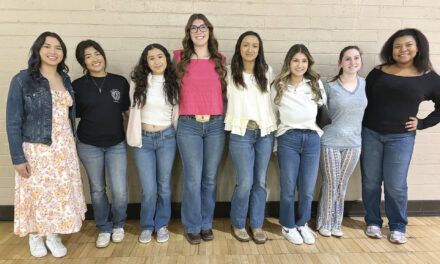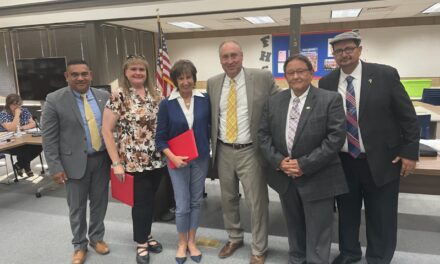Although there were many conversations across the school district surrounding a writing curriculum set to support English Learning Development (ELD) and English Language Arts (ELA) standards, the ball never started rolling—until now.
Records from the California Department of Education indicated that from 2023–2024, the Dos Palos Oro Loma Joint Unified School District (DPOLJU) student body was made up of approximately 27.2 percent of English learners.
Coincidentally, only 12.72 percent of those students were considered proficient in the English language, according to the test results from the English Language Proficiency Assessments for California.
Principal Sergio Contreras of Dos Palos Elementary (DPE), along with a group of teachers, stood before the DPOLJU School Board on Sept. 11 to present a curriculum designed to advance ELD and ELA for students across the district.
This curriculum was developed years prior at Marks Elementary (Marks), and later continued at DPE under Alec Bajalva, a former DPE Principal.
These discussions were part of a separate agenda item, the 2025–2026 Professional Development work plan with the Merced County Office of Education (MCOE).
The work plan outlined a $30,000 budget for DPE’s administrative faculty to have 20 days of coaching and professional development, but it did not include teachers or instructors.
On Aug. 21, during a school board meeting, members tabled the agenda item because they did not find the MCOE plan necessary. Furthermore, they believed that they needed a more thorough breakdown from Contreras and his team.
They had an existing contract for ELD reading but not for ELD writing. Board member Frank Lemos believed that the support from members of the MCOE was not necessary, and pre-existing staff could comply without it.
“I don’t see any reason to spend $30,000. We got people that are pretty sharp right here in this district,” said Lemos during the meeting.
In the September school board meeting, Assistant Superintendent Renee Leonard expressed that, although current faculty have some skills, they are not completely prepared.
She urged the school board to understand that the functions related to MCOE encompass a lot more than the standard, instructional rounds and Professional Learning Community (PLC) protocols.
“It is a bigger scope of work,” Leonard says. “[It is about] really developing that team in-house to support them.”
The DPE lesson plan was presented by Carey Demmers, Danny Valdez and Robin Pinto, a group of DPE teachers. The curriculum was centered on mini-lessons that use seven traits of writing and tie into ELA and ELD standards.
Instructors are set to dedicate 45 minutes to writing and use 10 to 15 minutes of that time on mini-lessons. Each trait is taught to every grade level, or age, at a different pace and through different methods.
The instructors are also provided with tools to help scaffold children so that lesson plans can be specific to language level. Afterward, students are categorized as emerging, expanding or bridging.
Demmers says that in the case of an emerging student, where a child may have very limited proficiency in English, they will need more indicators to help them understand the concepts.
“So in order for them to access a standard where they’re going to be working on sequencing, you might use picture cards,” Demmers says. “So they wouldn’t need a lot of language to do that, but they would still be getting the idea of the standard of sequencing,” she said.
Continuity of the curriculum and program was also highlighted throughout the presentation. The basis for the continuity is the implementation of rubrics and posters, which will showcase the growth of their skill set as they approach certain developmental stages.
Pinto expressed that this continuity is part of a larger effort and strategy that’s been built up over time. “We’re not starting fresh in each grade level. It’s not just one grade level doing it. It’s all of us working together as a team,” she said.
The rubric scores and more student examples collected from each grade level will allow instruction to be easier.
These examples act as models for teachers in the classroom and help facilitate a more relatable lesson. Demmers believes students respond very well to reviewing past students’ work.
“[Examples] pull actual student writing from years before, and they show the kids, ‘Hey, this was another student just like you,’ to look at the language they pulled out,” Demmers said.
Valdez added that teachers are also expected to give their students feedback and ideas on how to improve their writing during student-teacher conferences.
He also indicated that, in the past, Marks students were very ambitious. “[When] we started meeting with Marks a couple years ago, we started passing the process to Marks to continue it until TK5,” he says.
The group of teachers has already thought about the next steps and believes the ultimate challenge is time for staff training, access to more substitute teachers and getting both DPE and Marks back on track.
Ultimately, the motion passed 4–2, with Board President Maria Davis and Board Member Lisa Areias dissenting. This administrative support will be granted, and Contreras will be given additional assistance to lead his faculty through the implementation of this curriculum.
Although the future of the ELD and ELA curriculum is unclear, Mr. Contreras and his staff at DPE will continue to push for students whose first language is not English.



